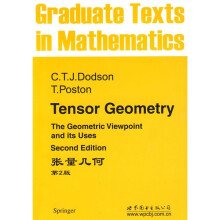张量几何(第2版)(英文版)

目 录内容简介
Introduction
0. Fundamental Not(at)ions
1. Sets
2. Functions
3. Physical Background
1. Real Vector Spaces
1. Spaces
Subspace geometry, components
2. Maps
Linearity, singularity, matrices
3. Operators
Projections, eigenvMues, determinant, trace
Ⅱ. Affine Spaces
1. Spaces
Tangent vectors, parallelism, coordinates
2. Combinations of Points
Midpoints, convexity
3. Maps
Linear parts, translations, components
Ⅲ. Dual Spaces
1. Contours, Co- and Contravariance, Dual Basis
Ⅳ. Metric Vector Spaces
1. Metrics
Basic geometry and examples, Lorentz geometry
2. Maps
Isometries, orthogonal projections and complements, adjoints
3. Coordinates
Orthonormal bases
4. Diagonalising Symmetric Operators
Principal directions, isotropy
Ⅴ. Tensors and Multilinear Forms
1. Multilinear Forms
Tensor Products, Degree, Contraction, Raising Indices
Vii Topological Vector Spaces
1. Continuity
Metrics: topologies, homeomorphisms
2. Limits
Convergence and continuity
3. The Usual Topology
Continuity in finite dimensions
4. Compactness and Completeness
Intermediate Value Theorem, convergence, extrema
Ⅶ. Differentiation and Manifolds
1. Differentiation
Derivative as local linear approxiamation
2. Manifolds
Charts, maps, diffeomorphisms
3. Bundles and Fields
Tangent and tensor bundles, metric tensors
4. Components
Hairy Ball Theorem, transformation formulae, raising indic
5. Curves
Parametrisation, length, integration
6. Vector Fields and Flows
First order ordinary differential equations
7. Lie Brackets
Commuting vector fields and flows
Ⅷ. Connections and Covariant Differentiation
1. Curves and Tangent Vectors
Representing a vector by a curve
2. Rolling Without Turning
Differentiation along curves in embedded manifolds
3. Differentiating Sections
Connections horizontal vectors, Christoffel symbols
4. Parallel Transport
Integrating a connection
5. Torsion and Symmetry
Torsion tensor of a connection
6. Metric Tensors and Connections
Levi-Civita connection
7. Covariant Differentiation of Tensors
Parallel transport, Riccis Lemma, components, constancy
Ⅸ. Geodesics
1. Local Characterisation
Undeviating curves
2. Geodesics from a Point
Completeness, exponential map, normal coordinates
3. Global Characterisation
Criticality of length and energy, First Variation Formula
4. Maxima, Minima, Uniqueness
Saddle points, mirages, Twins Paradox
5. Geodesics in Embedded Manifolds
Characterisation, examples
6. An Example of Lie Group Geometry
2x2 matrices as a pseudo-Riemannian manifold
Ⅹ. Curvature
1. Flat Spaces
Intrinsic description of local flatness
2. The Curvature Tensor
Properties and Components
3. Curved Surfaces
Ganssian curvature, Gauss-Bonnet Theorem
4. Geodesic Deviation
Tidal effects in spacetime
5. Sectional Curvature
Schurs Theorem, constant curvature
6. Ricci and Einstein Tensors
Signs, geometry, Einstein manifolds, conservation equation
7. The Weyl Tensor
Ⅺ. Special Relativity
1. Orienting Spacetimes
Causality, particle histories
2. Motion in Flat Spacetime
Inertial frames, momentum, rest mass, mass-energy
3. Fields
Matter tensor, conservation
4. Forces
No scalar potentials
5. Gravitational Red Shift and Curvature
Measurement gives a curved metric tensor
Ⅻ. General Relativity
I. How Geometry Governs Matter
Equivalence principle, free fall
2. What Matter does to Geometry
Einsteins equation, shape of spacetime
3. The Stars in Their Courses
Geometry of the solar system, Schwarzschild solution
4. Farewell Particle Appendix.Existence and Smoothness of Flows
1. Completeness
2. Two Fixed Point Theorems
3. Sequences of Functions
4. Integrating Vector Quantities
5. The Main Proof
6. Inverse Function Theorem
Bibliography
Index of Notations
Index
0. Fundamental Not(at)ions
1. Sets
2. Functions
3. Physical Background
1. Real Vector Spaces
1. Spaces
Subspace geometry, components
2. Maps
Linearity, singularity, matrices
3. Operators
Projections, eigenvMues, determinant, trace
Ⅱ. Affine Spaces
1. Spaces
Tangent vectors, parallelism, coordinates
2. Combinations of Points
Midpoints, convexity
3. Maps
Linear parts, translations, components
Ⅲ. Dual Spaces
1. Contours, Co- and Contravariance, Dual Basis
Ⅳ. Metric Vector Spaces
1. Metrics
Basic geometry and examples, Lorentz geometry
2. Maps
Isometries, orthogonal projections and complements, adjoints
3. Coordinates
Orthonormal bases
4. Diagonalising Symmetric Operators
Principal directions, isotropy
Ⅴ. Tensors and Multilinear Forms
1. Multilinear Forms
Tensor Products, Degree, Contraction, Raising Indices
Vii Topological Vector Spaces
1. Continuity
Metrics: topologies, homeomorphisms
2. Limits
Convergence and continuity
3. The Usual Topology
Continuity in finite dimensions
4. Compactness and Completeness
Intermediate Value Theorem, convergence, extrema
Ⅶ. Differentiation and Manifolds
1. Differentiation
Derivative as local linear approxiamation
2. Manifolds
Charts, maps, diffeomorphisms
3. Bundles and Fields
Tangent and tensor bundles, metric tensors
4. Components
Hairy Ball Theorem, transformation formulae, raising indic
5. Curves
Parametrisation, length, integration
6. Vector Fields and Flows
First order ordinary differential equations
7. Lie Brackets
Commuting vector fields and flows
Ⅷ. Connections and Covariant Differentiation
1. Curves and Tangent Vectors
Representing a vector by a curve
2. Rolling Without Turning
Differentiation along curves in embedded manifolds
3. Differentiating Sections
Connections horizontal vectors, Christoffel symbols
4. Parallel Transport
Integrating a connection
5. Torsion and Symmetry
Torsion tensor of a connection
6. Metric Tensors and Connections
Levi-Civita connection
7. Covariant Differentiation of Tensors
Parallel transport, Riccis Lemma, components, constancy
Ⅸ. Geodesics
1. Local Characterisation
Undeviating curves
2. Geodesics from a Point
Completeness, exponential map, normal coordinates
3. Global Characterisation
Criticality of length and energy, First Variation Formula
4. Maxima, Minima, Uniqueness
Saddle points, mirages, Twins Paradox
5. Geodesics in Embedded Manifolds
Characterisation, examples
6. An Example of Lie Group Geometry
2x2 matrices as a pseudo-Riemannian manifold
Ⅹ. Curvature
1. Flat Spaces
Intrinsic description of local flatness
2. The Curvature Tensor
Properties and Components
3. Curved Surfaces
Ganssian curvature, Gauss-Bonnet Theorem
4. Geodesic Deviation
Tidal effects in spacetime
5. Sectional Curvature
Schurs Theorem, constant curvature
6. Ricci and Einstein Tensors
Signs, geometry, Einstein manifolds, conservation equation
7. The Weyl Tensor
Ⅺ. Special Relativity
1. Orienting Spacetimes
Causality, particle histories
2. Motion in Flat Spacetime
Inertial frames, momentum, rest mass, mass-energy
3. Fields
Matter tensor, conservation
4. Forces
No scalar potentials
5. Gravitational Red Shift and Curvature
Measurement gives a curved metric tensor
Ⅻ. General Relativity
I. How Geometry Governs Matter
Equivalence principle, free fall
2. What Matter does to Geometry
Einsteins equation, shape of spacetime
3. The Stars in Their Courses
Geometry of the solar system, Schwarzschild solution
4. Farewell Particle Appendix.Existence and Smoothness of Flows
1. Completeness
2. Two Fixed Point Theorems
3. Sequences of Functions
4. Integrating Vector Quantities
5. The Main Proof
6. Inverse Function Theorem
Bibliography
Index of Notations
Index
目 录内容简介
《张量几何(第2版)(英文版)》是Springer数学研究生丛书之一,是一部详细讲述张量几何的教程。书中对微分几何的处理方式,以及学习广义相对论需要的数学知识使得本教程对于稍微了解单变量基本微积分和一些向量代数的知识就可以完全读懂该书的内容。《张量几何(第2版)(英文版)》用以书的形式能够提供的三维或更多维的图的形式使得内容更加形象化,重点强调数学的几何。为了表达的流畅和增强可读性,许多证明都是以练习的形式展示给读者,而非长篇的列举方程。这样,读者只能亲自进行实际计算,而不是跳过现成的例子。
这本内容丰富的教程对微分几何在相对论研究中的应用是个巨大的贡献。
这本内容丰富的教程对微分几何在相对论研究中的应用是个巨大的贡献。
比价列表








 缺书网
缺书网 扫码进群
扫码进群